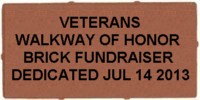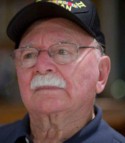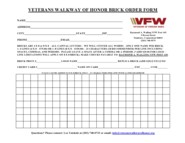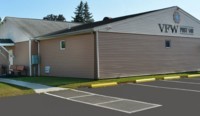Veterans
Walkway of Honor

Veterans Walkway of Honor Brick Fundraising Campaign sponsored by the
Raymond
A. Walling VFW Post 149, 5 Byron Street, Danbury, Connecticut 06810
John Esposito

John Esposito's service began in 1943, when barely eighteen years
old and a junior in High School, enlisted in the U.S. Marine Corps. John
says there was just something about the Corps that spoke to him
personally and while not sure exactly what it was, he knew he wanted to
be a Marine. John did his basic training at Parris Island and was assigned to a newly stood up unit, the 25th Marine Regiment of the 4th
Marine Division. He shipped out to Camp Lejeune, California
where he continued training until shipping out to the Pacific Theater
with the entire 4th Division. John was sent directly into combat and
received a baptism by fire at Roi-Namur, a small island near Kwajalein
in the Marshall Islands. This was the first of four heavily fortified
Islands where the teenage John Esposito would storm the beach with his
fellow Marines under massive Japanese machinegun and artillery fire.
Of
the millions of men who served in WWII, not many can say they hit the
beaches four times, but that is exactly what John Esposito did. After
Roi-Namur, John landed at Saipan, the largest of the Marshall Islands
where the Japanese put up a dogged resistance. John, a motor squad
leader, was with the lead Regiment of the 4th Marines that spearheaded
the beach assault. Despite the massive naval bombardment, the Japanese were well dug
in and waited until the Marines hit the beach to open fire. It
took the Marines and two Army divisions more than three weeks and
thousands of casualties to clear Saipan. But even after the battle ended,
the horrors of war continued as John reluctantly recounted watching
in horror as Japanese soldiers and civilians threw themselves off
cliffs rather than surrender to the Americans. He and his fellow Marines
tried to help, attempting to get the Japanese to surrender in order to provide
them medical care and food, but they would not give up. Even the island's women
and children committed suicide. John watched in horror as parents
threw themselves with their children off of the island's towering
cliffs.
After Saipan, there was no break for John as his regiment was sent across a small Pacific channel to assault the island of
Tinian. There he faced another three days of heavy close quarter combat
before Japanese resistance finally collapsed. After taking Tinian, the
25th Regiment was sent to Hawaii where most of the regiment expected
their Pacific tour to end. However, they were wrong and their greatest
battle lay ahead. In January 1945, John was shipped out to take the
fortress island of Iwo Jima. On the morning of February 10, 1945, John
climbed into an amphibious personnel carrier and headed for the "Sands
of Iwo Jima." He recalls seeing Mount Suribachi and how it dominated the
beach below with its hive of Japanese defenders.
As in past
landings, the Navy had bombarded the Japanese defenses which at first
seemed to be all but destroyed as the Marines who first landed
encountered little resistance. However, this was part of the Japanese
battle plan - to let the Marines land and fill the beaches with troops
and equipment and then trap them in a killing zone of massive crossfires
with little room for maneuver and even less cover. It was into this
killing zone that John Esposito charged upon leaving his assault
vehicle. Once ashore he and thousands of other Marines were racked with
machinegun and artillery fire as they struggled to find cover in the
volcanic ash beaches. Casualties quickly mounted and many who survive
spoke of a feeling being sitting ducks with the Japanese pouring fire
down from the high ground. In John's regiment, one in every three Marines
were either killed or wounded - one of the highest casualty rates
suffered by the United States military in WWII.
After hours of
intense combat, John was seriously injured by gunfire in the arm and face
and today still carries part of a Japanese bullet in his elbow. While
the wounds ended John's combat service, he fought to make a full recovery.
He spent months of physical therapy before returning to Danbury. John
earned, among many other medals and commendations, the Purple Heart and
the Asiatic Pacific Campaign Medal with 4 stars for his service in some
of the most intense combat of WWII.
(Contributed by Tom Saadi)



